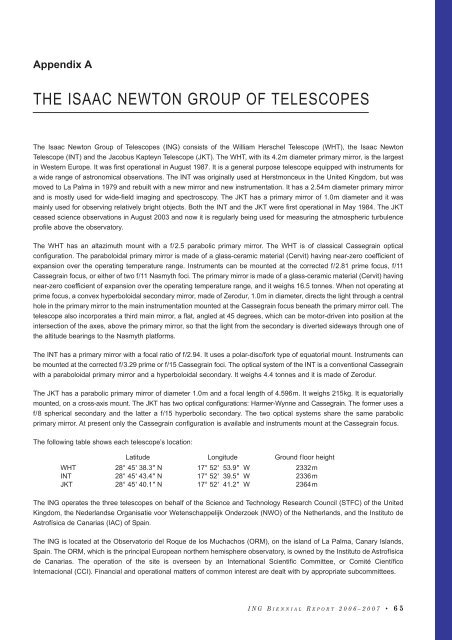PDF (6M) - Isaac Newton Group of Telescopes - Instituto de ...
PDF (6M) - Isaac Newton Group of Telescopes - Instituto de ...
PDF (6M) - Isaac Newton Group of Telescopes - Instituto de ...
Create successful ePaper yourself
Turn your PDF publications into a flip-book with our unique Google optimized e-Paper software.
Appendix A<br />
THE ISAAC NEWTON GROUP OF TELESCOPES<br />
The <strong>Isaac</strong> <strong>Newton</strong> <strong>Group</strong> <strong>of</strong> <strong>Telescopes</strong> (ING) consists <strong>of</strong> the William Herschel Telescope (WHT), the <strong>Isaac</strong> <strong>Newton</strong><br />
Telescope (INT) and the Jacobus Kapteyn Telescope (JKT). The WHT, with its 4.2m diameter primary mirror, is the largest<br />
in Western Europe. It was first operational in August 1987. It is a general purpose telescope equipped with instruments for<br />
a wi<strong>de</strong> range <strong>of</strong> astronomical observations. The INT was originally used at Herstmonceux in the United Kingdom, but was<br />
moved to La Palma in 1979 and rebuilt with a new mirror and new instrumentation. It has a 2.54m diameter primary mirror<br />
and is mostly used for wi<strong>de</strong>-field imaging and spectroscopy. The JKT has a primary mirror <strong>of</strong> 1.0m diameter and it was<br />
mainly used for observing relatively bright objects. Both the INT and the JKT were first operational in May 1984. The JKT<br />
ceased science observations in August 2003 and now it is regularly being used for measuring the atmospheric turbulence<br />
pr<strong>of</strong>ile above the observatory.<br />
The WHT has an altazimuth mount with a f/2.5 parabolic primary mirror. The WHT is <strong>of</strong> classical Cassegrain optical<br />
configuration. The paraboloidal primary mirror is ma<strong>de</strong> <strong>of</strong> a glass-ceramic material (Cervit) having near-zero coefficient <strong>of</strong><br />
expansion over the operating temperature range. Instruments can be mounted at the corrected f/2.81 prime focus, f/11<br />
Cassegrain focus, or either <strong>of</strong> two f/11 Nasmyth foci. The primary mirror is ma<strong>de</strong> <strong>of</strong> a glass-ceramic material (Cervit) having<br />
near-zero coefficient <strong>of</strong> expansion over the operating temperature range, and it weighs 16.5 tonnes. When not operating at<br />
prime focus, a convex hyperboloidal secondary mirror, ma<strong>de</strong> <strong>of</strong> Zerodur, 1.0m in diameter, directs the light through a central<br />
hole in the primary mirror to the main instrumentation mounted at the Cassegrain focus beneath the primary mirror cell. The<br />
telescope also incorporates a third main mirror, a flat, angled at 45 <strong>de</strong>grees, which can be motor-driven into position at the<br />
intersection <strong>of</strong> the axes, above the primary mirror, so that the light from the secondary is diverted si<strong>de</strong>ways through one <strong>of</strong><br />
the altitu<strong>de</strong> bearings to the Nasmyth platforms.<br />
The INT has a primary mirror with a focal ratio <strong>of</strong> f/2.94. It uses a polar-disc/fork type <strong>of</strong> equatorial mount. Instruments can<br />
be mounted at the corrected f/3.29 prime or f/15 Cassegrain foci. The optical system <strong>of</strong> the INT is a conventional Cassegrain<br />
with a paraboloidal primary mirror and a hyperboloidal secondary. It weighs 4.4 tonnes and it is ma<strong>de</strong> <strong>of</strong> Zerodur.<br />
The JKT has a parabolic primary mirror <strong>of</strong> diameter 1.0m and a focal length <strong>of</strong> 4.596m. It weighs 215kg. It is equatorially<br />
mounted, on a cross-axis mount. The JKT has two optical configurations: Harmer-Wynne and Cassegrain. The former uses a<br />
f/8 spherical secondary and the latter a f/15 hyperbolic secondary. The two optical systems share the same parabolic<br />
primary mirror. At present only the Cassegrain configuration is available and instruments mount at the Cassegrain focus.<br />
The following table shows each telescope’s location:<br />
Latitu<strong>de</strong> Longitu<strong>de</strong> Ground floor height<br />
WHT 28° 45' 38.3" N 17° 52' 53.9" W 2332m<br />
INT 28° 45' 43.4" N 17° 52' 39.5" W 2336m<br />
JKT 28° 45' 40.1" N 17° 52' 41.2" W 2364m<br />
The ING operates the three telescopes on behalf <strong>of</strong> the Science and Technology Research Council (STFC) <strong>of</strong> the United<br />
Kingdom, the Ne<strong>de</strong>rlandse Organisatie voor Wetenschappelijk On<strong>de</strong>rzoek (NWO) <strong>of</strong> the Netherlands, and the <strong>Instituto</strong> <strong>de</strong><br />
Astr<strong>of</strong>ísica <strong>de</strong> Canarias (IAC) <strong>of</strong> Spain.<br />
The ING is located at the Observatorio <strong>de</strong>l Roque <strong>de</strong> los Muchachos (ORM), on the island <strong>of</strong> La Palma, Canary Islands,<br />
Spain. The ORM, which is the principal European northern hemisphere observatory, is owned by the <strong>Instituto</strong> <strong>de</strong> Astr<strong>of</strong>ísica<br />
<strong>de</strong> Canarias. The operation <strong>of</strong> the site is overseen by an International Scientific Committee, or Comité Científico<br />
Internacional (CCI). Financial and operational matters <strong>of</strong> common interest are <strong>de</strong>alt with by appropriate subcommittees.<br />
ING BIENNIAL R EPORT 2006–2007 • 65
















